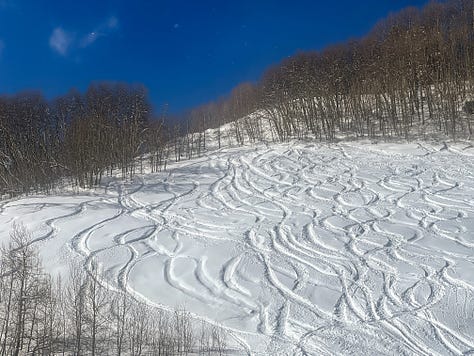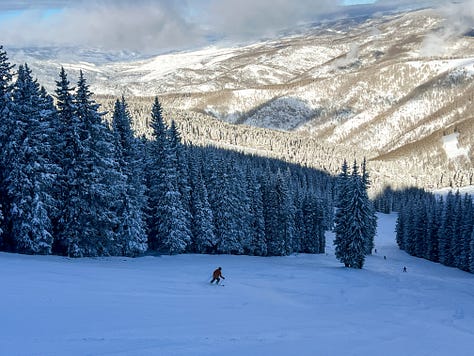Snow journalism, snow drought, and snow photos
I'm building a bibliography of recent snow-related journalism that showcases great reporting, writing, and visual storytelling
Snow journalism reading list
Over the past few years, I’ve been collecting news stories connected to snow, thinking I’d one day do a project like Snow News.
This journalism has been super helpful in educating me about snow-related topics, so I’ve created this page with links to some of the best and most interesting work that I’ve encountered.
If you’re looking for a crash course on snow and the West’s snowpack—plus amazing reporting, writing, and visual storytelling from underpaid/overworked journalists—you should check out the collection. The list now has 50 stories; I’ll keep updating the page with new content.
In a 2019 piece for The Water Desk, I made the case for the subgenre of “water journalism,” so it should come as no surprise that I also think that “snow journalism” is a thing.
If Gannett, the nation’s largest newspaper chain (and my former employer), can hire reporters to cover Taylor Swift and Beyoncé, I think snow is also worthy of a “beat.” I started this newsletter to do some snow journalism myself, and to amplify the work of others who cover snow and the snowpack.
I’ve lumped the stories into the following categories, which admittedly don’t cover the full gamut of snow-related issues:
Atmospheric rivers
Avalanches, flooding, and natural hazards
Climate change and drought
Cloud seeding
Data visualization
Dust on snow
Skiing and winter sports
Studying the snowpack
Wildfires and forest health
If you have a suggestion for other content to include, please email me.
Snow drought update
Recent atmospheric rivers boosted the snowpack in parts of the West, but many watersheds are still mired in a snow drought, which can be caused not only by a lack of precipitation but also by warm temperatures that favor raindrops over snowflakes.
The February 14 map below shows that snow water equivalent (SWE) was near or above the long-term median in Arizona, New Mexico, Utah, Colorado, and much of Nevada, while conditions were lousy in Washington and Montana, plus parts of Wyoming, Idaho, and California.
As I noted in an earlier post, El Niño conditions tilt the odds toward such a geographic pattern in the American West—wetter than normal in the south and drier conditions to the north—but we may be switching to La Niña.
In California, the potent atmospheric rivers that caused flooding at lower elevations were good news for the Sierra snowpack. Yet the statewide average on February 14 was still 73% of normal and a shadow of last year’s epic season, as shown in the graphic below.
Moving to Montana, the chart below shows that statewide snowpack remains at record-low levels. With about two months to go until the median peak on April 14, Montana’s snowpack is just 68% of normal.
Earlier this month, the lack of snow and unusually warm weather forced Montana’s Teton Pass ski area to prematurely end its season.
“We are simply experiencing the lowest levels of moisture ever recorded at our site in 55 years of recording data!” owner Charles Hlavac wrote in a heartfelt February 8 letter to patrons that included dismal graphics like the one above and photos of bare ground at the ski area. “Last week we saw temps north of 50 degrees all week combined with intermittent rain. This destroyed what little snowpack we had.”
Several other ski areas in the region are shuttered, according to SAM Magazine (“SAM” = ski area management):
. . . Teton Pass joined a growing list of ski areas that have either shut down or never opened this season due to lack of snow. Montana’s Turner Mountain Ski Area announced on Jan. 26 that it was closing until when and if more snow arrived. And Cody, Wyo., ski area Sleeping Giant announced in January that a combination of damage to its snowmaking system and a lack of natural show was shutting down its 2023-24 season.
The geographic extent of the West’s snow drought has decreased since early January, but SWE readings were below normal at 78% of stations as of February 4, according to a February 7 update from the National Integrated Drought Information System.
“A recent rain-on-snow event and a winter heat wave in the Cascade Range intensified warm snow drought conditions,” according to the update. There was even prolonged snowmelt at high-elevation locations, with one site at 5,370 feet near Mount Hood losing nearly four inches of SWE from January 27 to February 5.
The map below shows changes in SWE from January 19 to February 3 in the Pacific Northwest. Red circles show stations that registered record-setting losses during the period, while orange circles indicate the second-worst losses for the period of record.
For an excellent overview of what’s at stake as the Pacific Northwest’s snowpack shrinks due to climate change, check out this recent story by Conrad Swanson of The Seattle Times, which I’ve also included in the snow journalism bibliography.
“Precipitation that once fell as snow is instead falling as rain, and the snow that does reach the ground is melting earlier in the year as our dry season trends longer and hotter,” Swanson writes. “All told, Washington will see more water when it doesn’t need it and less water when it does.”
Far away in Arizona, the snowpack is also essential for the water supply. If you’d like to see how that state’s Salt River Project measures the snowpack, visual journalists from two Phoenix television stations—12News and ABC15—recently tagged along with hydrologists who were manually collecting data.
From Purgatory to Vail: am I underdressed?
Since moving from Denver to Durango in 2021, I’ve done most of my skiing and snowboarding at nearby Purgatory, reveling in the relative lack of traffic and crowds. While I don’t miss the insanity of I-70, I do pine for the many legendary ski areas along that heavily traveled mountain corridor. So it was a real treat earlier this month when I got to ski with friends at Vail for a few days without having to make the often dreadful drive up from the Front Range.
Below is a gallery of photos (click to enlarge images) from my time at Vail, where we enjoyed two glorious powder days followed by bluebird conditions. Vail’s ginormous, glacially carved back bowls are something else. Another highlight for this shutterbug and weather nerd was a misty morning that featured fog filtering the sunlight and an impressive layer of ice crystals coating the chairlifts.









Switching from Purgatory to Vail entails alpine culture shock: Vail is Colorado’s largest resort and a glitzy international destination with more than triple the number of skiable acres as Purg. I saw so many beautiful people in shiny, expensive outfits! I also heard so many foreign languages spoken by visitors from Europe, Asia, and Latin America.
At Purg, the tourists tend to be people who’ve driven up from New Mexico and Texas, rather than the jet-setting glitterati. And the dirtbag aesthetic with duct tape patches is definitely more in style down here; after all, USA Today named Durango the “Worst Dressed Town in America” in the 1990s, “but that’s a badge worn with honor,” according to our local boosters.
Full disclosure: this post was written while I was wearing old sweatpants.








That's quite a reading list, Mitch!
Thanks, Mark, I'm a sucker for great journalism, especially if it's connected to snow!